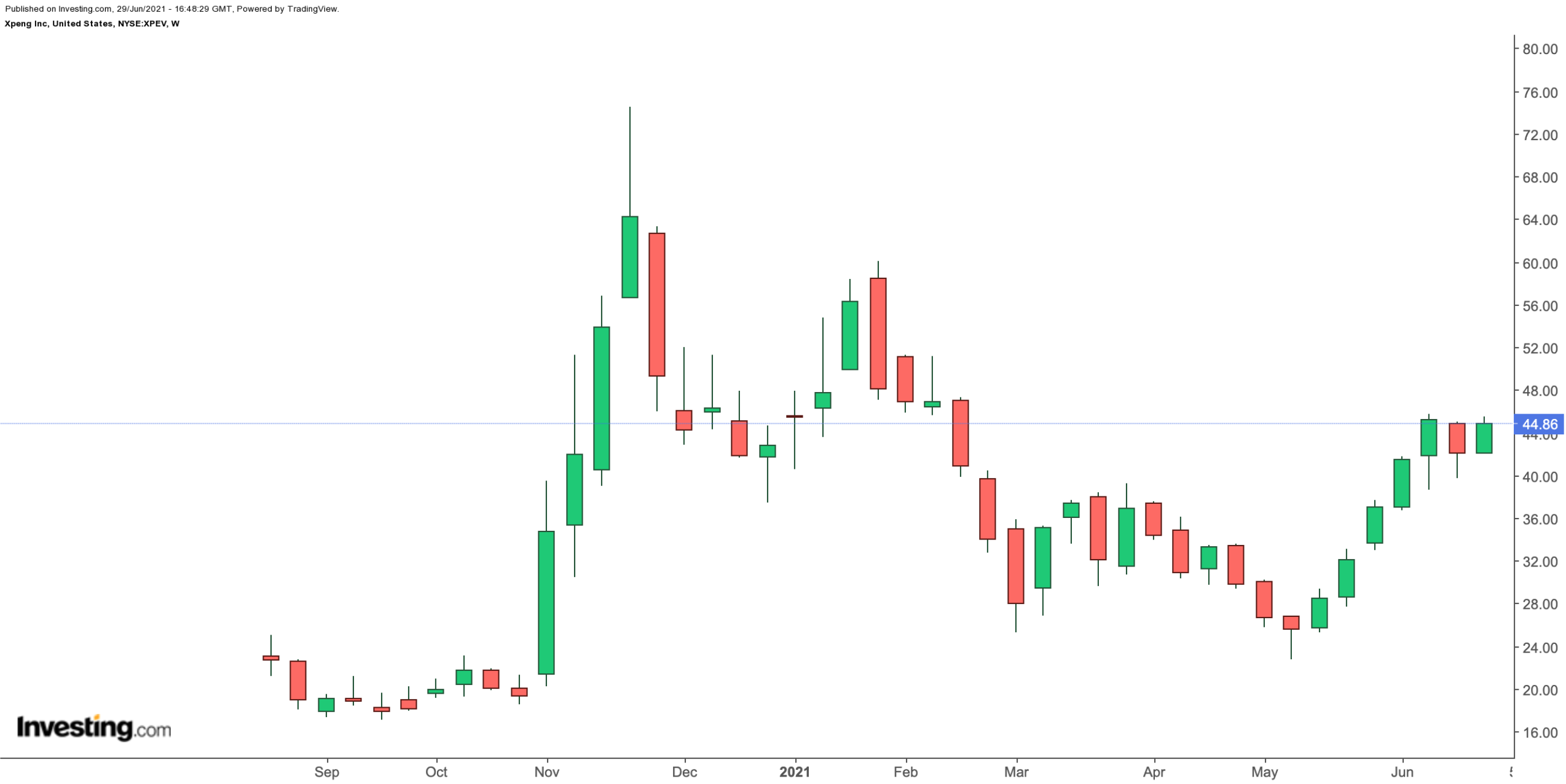Chinese electric vehicle group Xpeng (NYSE:XPEV) released Q1 metrics on May 13. Since then, XPEV shares have returned more than 90%. The stock is currently trading around $44.90.
So today we outline how investors could consider a covered call strategy to protect some of their recent gains in the car manufacturer. It could also help decrease the volatility of the portfolio position.
In recent months we covered how to initiate covered calls on several popular stocks. Readers who are new to options might consider revisiting the initial article in the series before reading this post as well as the discussion on another Chinese EV darling Nio (NYSE:NIO) stock.
Xpeng Stock’s Recent Earnings
52-Week Range: $17.11– $74.49
Year-to-Date Price Change: Up about 3.1%
Recent EV metrics highlight that there are more than 31 car manufacturers in China in this space, and Xpeng is among the top 10. China's home grown EV names are each aiming to become the next Tesla (NASDAQ:TSLA), whose stock is down right now about 3.4% YTD.
Xpeng listed as an American depositary receipt (ADR) on the New York Stock Exchange in August 2020, when it started trading at $23.10. In a matter of weeks, it hit an all-time-low of $17.11, only to then have a stellar run-up to a record-high of $74.49 by Nov. 24, 2020.

Since that date it has been a downhill and choppy ride for those early shareholders. However, investors who bought following the Q1 earnings results of mid-May have almost doubled their investments.
For the quarter, total revenue came in at RMB2.95 billion (or $450.4 million), an increase of 616.1% from the same period in 2020. Non-GAAP basic and diluted net loss per ADS was RMB0.88 (or 13 cents).
CEO He Xiaopeng commented:
“The first quarter kicked off a great start to 2021 with a record-breaking vehicle deliveries notwithstanding seasonally slower demand for automobiles and the semiconductor shortage.”
For Q2 2021, the company expects total revenue to be between RMB3.4 billion and RMB3.5 billion, representing a year-over-year increase of 475.5% to 492.4%.
XPEV shares are trading at 27.7 times sales. By comparison, P/S ratio for Tesla and Nio stocks are 21.4x and 18.3x.
Covered Calls On XPEV Stock
For every 100 shares held, the trader needs to sell one XPEV call option with an expiration date at some time in the future.
Intraday Tuesday, Xpeng stock was trading at $44.90. Therefore, for this article, we'll use that price.
Investors who believe there could be short-term profit-taking soon might use a slightly in-the-money (ITM) covered call. A call option is ITM if the market price (here, $44.90) is above the strike price ($40).
So, the investor would buy (or already own) 100 shares of XPEV stock at $44.90 and, at the same time, sell a XPEV Aug. 20, 2021, 40-strike call option. This option is currently offered at a price (or premium) of $7.33.
An option buyer would have to pay $7.33 X 100 (or $733) in premium to the option seller. This call option will stop trading on Friday, Aug. 20.
Assuming a trader would now enter this covered call trade at $44.90, at expiration, the maximum return would be $243, i.e., ($733 - ($44.90 - $40) X 100), excluding trading commissions and costs.
Risk/Reward Profile For Unmonitored Covered Call
An ITM covered call's maximum profit is equal to the extrinsic value of the short call option.
The intrinsic value would be the tangible value of the option if it were exercised now. Thus, our Xpeng call option's intrinsic value is ($44.90 - $40) X 100, or $490.
The extrinsic value is the difference between the market price of an option (or the premium) and its intrinsic price. Here, the extrinsic value would be $243, i.e., ($733 - $490). Extrinsic value is also known as time value.
The trader realizes this gain of $243 as long as the price of XPEV stock at expiration remains above the call option's strike price (i.e., $44.00).
On expiration day, if the stock closes below the strike price, the option would not get exercised, but would instead expire worthless. Then, the stock owner with the covered call position gets to keep the stock and the money (premium) s/he was paid for selling the option.
At expiration, this trade would break even at an Xpeng stock price of $37.57 (i.e., $44.90 - $7.33), excluding trading commissions and costs.
On Aug. 20, if Xpeng stock closes below $37.53, the trade would start losing money within this covered call setup.
Therefore, by selling the covered call, the investor has some protection against a potential loss in the case of a decline in the underlying shares. In theory, a stock's price could drop to $0.
What If XPEV Stock Reaches A New All-Time High?
As we have noted in earlier articles, a covered call limits the upside profit potential. The risk of not participating in Xpeng stock's potential appreciation fully might not appeal to everyone. However, within their risk/return profiles, others might find that acceptable in exchange for the premium received.
For example, if XPEV shares were to reach a new high for 2021 and close at $75 on Aug. 20, the trader's maximum return would still be $243. In such a case, the option would be deep ITM and would likely be exercised. There might also be brokerage fees if the stock is called away.
Bottom Line
Xpeng stock has been on fire over the past six weeks and, long term, we are bullish on the Chinese EV maker. With a market capitalization around $36 billion, it still has further room for growth. However, such a covered call strategy could help navigate potential sideways moves or even drops in XPEV price in the coming weeks.
